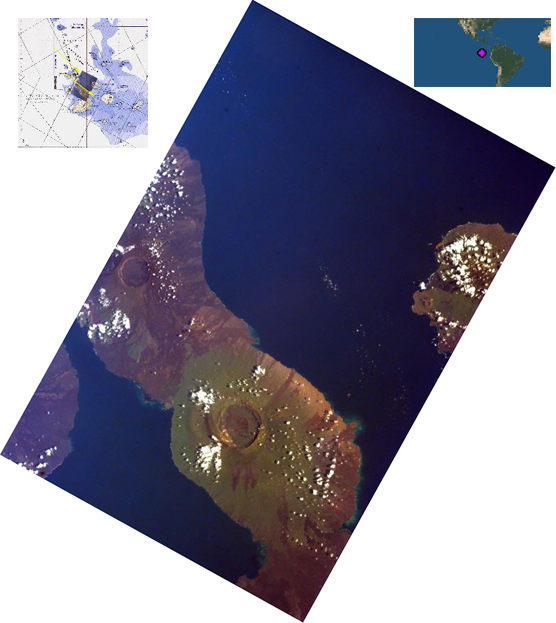Favorite Image: STS099.ESC.05210433
Isla Isabella, Galapagos Islands
This image of the Galapagos Islands captures two large shield volcanoes on Isla Isabella, the largest and least inhabited island in the Galapagos chain. The northern volcano is called Volcan Darwin and the southern volcano is called Volcan Alcedo. Isla Fernandina and Isla San Salvador are just visible on either side of Isla Isabella.
The western Galapagos Islands, which lie about 750 miles west of Ecuador in the eastern Pacific Ocean, have six active volcanoes similar to the volcanoes found in Hawaii. These are shield volcanoes shaped like flattened domes, broad and low, built by flows of very fluid lava. These volcanoes reflect the volcanic processes that occur when the ocean floor is created. The islands are largely desolate lava piles with little vegetation along the coastlines. However, the high volcanic mountains generate rains that have mantled the summits with dense jungle. The islands are famous not only for their volcanic associations but also for the peculiar flora and fauna that evolved due to isolation from any continental mainland.
Since the time of Charles Darwin's visit to the area in 1835, there have been more than 60 recorded eruptions from these volcanoes. Unlike Hawaii, these volcanoes are infrequently studied due to their inaccessibility and surrounding delicate ecology. In addition, the rugged terrain and lack of water and field support make these volcanoes difficult to map and observe. A major eruption on Isla Fernandina in 1974 went unnoticed on the ground until observed by astronauts aboard the Skylab 4.
The western Galapagos Islands, which lie about 750 miles west of Ecuador in the eastern Pacific Ocean, have six active volcanoes similar to the volcanoes found in Hawaii. These are shield volcanoes shaped like flattened domes, broad and low, built by flows of very fluid lava. These volcanoes reflect the volcanic processes that occur when the ocean floor is created. The islands are largely desolate lava piles with little vegetation along the coastlines. However, the high volcanic mountains generate rains that have mantled the summits with dense jungle. The islands are famous not only for their volcanic associations but also for the peculiar flora and fauna that evolved due to isolation from any continental mainland.
Since the time of Charles Darwin's visit to the area in 1835, there have been more than 60 recorded eruptions from these volcanoes. Unlike Hawaii, these volcanoes are infrequently studied due to their inaccessibility and surrounding delicate ecology. In addition, the rugged terrain and lack of water and field support make these volcanoes difficult to map and observe. A major eruption on Isla Fernandina in 1974 went unnoticed on the ground until observed by astronauts aboard the Skylab 4.








